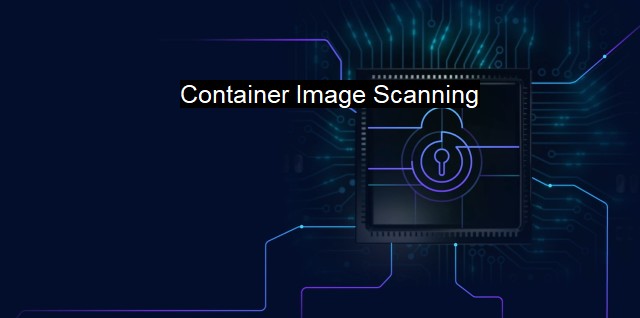What is Container Image Scanning?
Securing Container Workloads: The Role of Container Image Scanning in Cybersecurity for Businesses
Container Image Scanning is an essential strategy that plays a pivotal role in the realm of cybersecurity. It involves the complex process of examining container images and identifying any vulnerabilities that may exist within these images, which are essentially a lightweight, standalone, and executable software package that includes everything needed to run a piece of software, including the code, a runtime, libraries, environment variables, and config files.As containment strategies become increasingly popular in the development world, it’s crucial to ensure they are devoid of any threatening or malicious substances which could potentially oversee cybersecurity failures. This is where Container Image Scanning becomes vital.
For context, it is important to elucidate the underlying concepts of containers further. Containers expedite the process, allowing developers to encapsulate the application, isolate it, and deploy it into different environments. One crucial aspect of containers is their 'image.' A container image is a lightweight, standalone executable software package that includes everything necessary to run the pieces of software involved.
Container Image Scanning is the thorough inspection and examination of these images to identify existing vulnerabilities. The objective is to target weak spots and eradicate them before cyber adversaries exploit them. This proactive approach contributes significantly to enhanced cybersecurity defenses.
Scanning Container Images goes beyond identifying system vulnerabilities. It can also help detect malwares. Malwares, pernicious as they are, are intended to cause damage and disrupt systems, from phishing schemes to ransomware attacks. Scanning the image and checking the layers of the container for viruses or malware can strengthen the defense process, securing the integrity of the software.
Container Image Scanning also serves as an efficient mechanism to bring about regulatory compliance. It ensures that the use of containers does not compromise the security regulations a company must follow. This is especially instrumental for businesses that must abide by stringent data management, data privacy, or certain broader regulatory environmental issues.
One of the potential caveats in the scanning process is its interpretation. The results returned from a Container Image Scanning process include the details of each vulnerability, such as its location and severity, type of malware found, and the procedures to remediate them for enhancing system resilience. the interpretation requires an advanced level of expertise to determine an appropriate response strategy appropriately.
Further, there is an array of scanning tools available, with each exhibiting different features and capabilities. The effective and efficient scanning tools employ a hybrid model including both signature-based detection - looking for known vulnerabilities by referencing a database of previously reported issues, and behavioral detection - looking at the bigger picture of how the components of a container image operate in relation.
Integration of scanning into CI/CD (Continuous Integration and Continuous Development) pipeline is another crucial approach associated with Container Scanning. This practice can provide inputs and reinforcements at various stages of the software development lifecycle, consequently formulating proactive steps towards thwarting potential cybersecurity pitfalls.
Container Image Scanning serves as an instrumental measure to enhancing an organization's resilience against unforeseen cybersecurity threats. By thoroughly scanning malware, analyzing the results, remediating the risks, and bolstering the defense mechanisms, Container Image Scanning stands as a vital element in today's constantly changing cybersecurity landscape. Keeping updating scanning tools to capture the emergent vulnerabilities is intrinsic to remain one step ahead of cyber adversaries. A crucial component of a broader security strategy, it poses an efficient deterrent against unanticipated cybersecurity crises.

Container Image Scanning FAQs
What is container image scanning?
Container image scanning is the process of analyzing and evaluating the security of a container image to detect any vulnerabilities or malware that may be present. This is done by comparing the image to a database of known threats and risks.Why is container image scanning important in cybersecurity?
Container image scanning is important in cybersecurity because it allows for the early detection and prevention of malware and vulnerabilities in the container. It helps to ensure that the container is safe to deploy or run, and can help to protect against potential cyber attacks.How is container image scanning different from antivirus software?
Container image scanning and antivirus software are similar in that they both scan for malware, but they are different in their approach. Antivirus software typically scans files and directories for known threats, while container image scanning looks at the entire image and compares it to a database of known vulnerabilities and risks.What are some benefits of using container image scanning?
Some benefits of using container image scanning include early detection of vulnerabilities and malware, improved security and compliance, better risk management, and reduced risk of cyber attacks. It can also help to ensure that your organization is following best practices and staying up-to-date with the latest security trends.| | A | | | B | | | C | | | D | | | E | | | F | | | G | | | H | | | I | | | J | | | K | | | L | | | M | |
| | N | | | O | | | P | | | Q | | | R | | | S | | | T | | | U | | | V | | | W | | | X | | | Y | | | Z | |
| | 1 | | | 2 | | | 3 | | | 4 | | | 7 | | | 8 | | |||||||